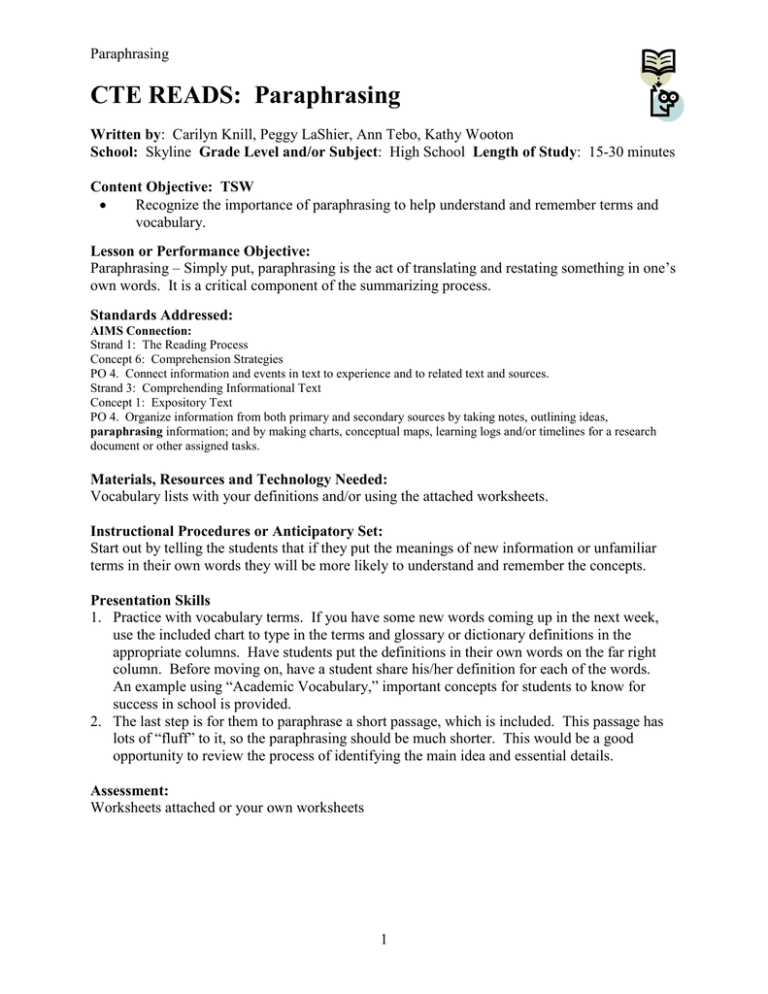CTE READS: Paraphrasing
advertisement

Paraphrasing CTE READS: Paraphrasing Written by: Carilyn Knill, Peggy LaShier, Ann Tebo, Kathy Wooton School: Skyline Grade Level and/or Subject: High School Length of Study: 15-30 minutes Content Objective: TSW Recognize the importance of paraphrasing to help understand and remember terms and vocabulary. Lesson or Performance Objective: Paraphrasing – Simply put, paraphrasing is the act of translating and restating something in one’s own words. It is a critical component of the summarizing process. Standards Addressed: AIMS Connection: Strand 1: The Reading Process Concept 6: Comprehension Strategies PO 4. Connect information and events in text to experience and to related text and sources. Strand 3: Comprehending Informational Text Concept 1: Expository Text PO 4. Organize information from both primary and secondary sources by taking notes, outlining ideas, paraphrasing information; and by making charts, conceptual maps, learning logs and/or timelines for a research document or other assigned tasks. Materials, Resources and Technology Needed: Vocabulary lists with your definitions and/or using the attached worksheets. Instructional Procedures or Anticipatory Set: Start out by telling the students that if they put the meanings of new information or unfamiliar terms in their own words they will be more likely to understand and remember the concepts. Presentation Skills 1. Practice with vocabulary terms. If you have some new words coming up in the next week, use the included chart to type in the terms and glossary or dictionary definitions in the appropriate columns. Have students put the definitions in their own words on the far right column. Before moving on, have a student share his/her definition for each of the words. An example using “Academic Vocabulary,” important concepts for students to know for success in school is provided. 2. The last step is for them to paraphrase a short passage, which is included. This passage has lots of “fluff” to it, so the paraphrasing should be much shorter. This would be a good opportunity to review the process of identifying the main idea and essential details. Assessment: Worksheets attached or your own worksheets 1 Paraphrasing Stating the Meanings in Your Own Words Example using important academic vocabulary Topic : Words students need to know for success in school Complete the final column of the chart below by putting the meaning of the word that is defined for you into your own words. Term Access Definition The action, ability, right, or permission to approach, enter, or use. Paraphrased meaning Assess To determine the value, significance, or extent of; appraise. Attribute A quality belonging to a person, thing, group, etc. A characteristic of something. Component A part, element, or ingredient of something. Context The set of circumstances or facts that surround a particular event, situation, etc. 2 Paraphrasing Stating the Meanings in Your Own Words Topic ________________________ Complete the final column of the chart below by putting the meaning of the word that is defined for you into your own words. Term Definition Paraphrased meaning 3 Paraphrasing Name ____________________________ Practicing Paraphrasing When asked to write a report, it is very tempting to copy sentences word for word from the source. However, when this is done, the student is plagiarizing, which is against the law, and is likely to result in a failing grade. Instead, you should paraphrase the information. Paraphrasing simply refers to putting what someone else has said or written into your own words. A trick to be good at paraphrasing is to not have the written material in front of you when putting the ideas into your own words. That way you won’t be tempted to look at and copy it! If you can learn to paraphrase using words that are meaningful to you it is more likely that you will understand the new terms and concepts. 4
